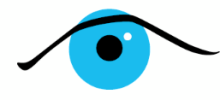Originally appeared in
Earth Star magazine
October/ November 2006
By Rosemary Gaddum Gordon, D.B.O., M.A.
Have you ever noticed how large the moon looks when it rises and how it seems to shrink as it climbs higher into the sky? As the moon passes through the heavens, it seems to start off close to us, go further away and then come back to being close to us again. In fact, the moon’s distance away from the earth during one diurnal cycle is almost constant. It is the eye-brain connection that causes us to think that it changes size, which in turn leads us to think it moves further away from us when it is at it’s zenith.
Our understanding of what we see is learned. As we begin to crawl around, we learn how far away things are and how they appear to get larger as we approach. We use this knowledge all the time. It helps us know the distance and speed of an approaching vehicle, so we know when it’s safe to cross the road. When we see the moon, which is actually too far away and too large for our experience to fathom, our eyes are deceived and we are confused.
If you did the exercise I suggested last month and held your finger up in front of something in the distance, you may have been confused to notice some doubling of objects. When our eyes are working well together and we look at an object, we see two of any object that is in front of or behind the one we’re looking at. Surprisingly, seeing double sometimes shows us we have normal vision. It shows that both the eyes are switched on at the same time and that we have some awareness of the peripheral field. (We’ll explore the peripheral field in the next issue.)
If you hold your finger up in front of a distant object, look at the finger and move it towards you, you will notice that the two objects in the distance will appear to move. The same is true if you look at the distant object and move your finger back and forth. This is another clue that helps the brain know how fast something is moving.
A good use of the doubling illusion is if you practice archery. Instead of closing one eye to aim, look at the target and move the arrow so you see the bull’s eye centered between the two illusory arrowheads. You’ll be right on target.
If you have trouble seeing double in this way, it usually means that one of your eyes is switched off. You can explore which eye it is by covering and uncovering each one and noticing what happens. To help switch that eye back on, rest your eyes first with palming. (Cover your closed eyes with your hands, without touching them, and relax your mind.) Next cover the stronger eye for thirty seconds while you look at your finger and see the background, then, when you remove the cover see if you can see the doubling.
Because seeing these illusions can be confusing, we usually ignore them. If, however, you practice them consciously they can help strengthen the way your eyes work together and how your brain calculates speed, size, distance and location of things in the world.


Sorry, comments are closed for this post.